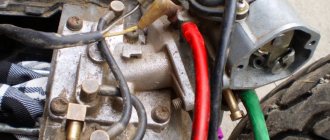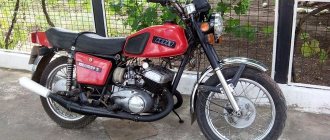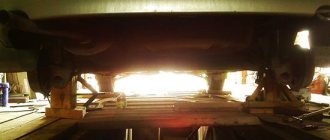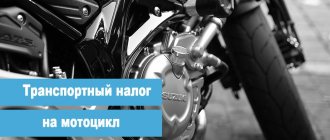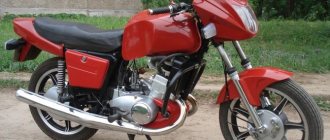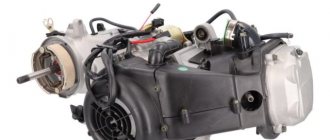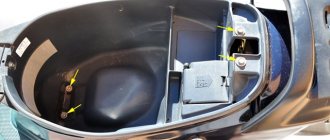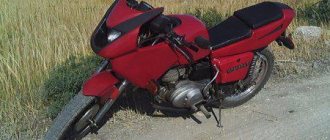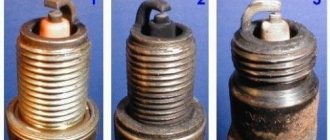Introduction
When choosing tires, beginners are often faced with the need to decipher the markers that literally litter both sides of the tire.
This long list of letters and numbers can confuse anyone who encounters the manufacturer's coding for the first time. In the article we will talk in detail about what each letter and number on the surface of the tire means. After reading the material, not a single symbol on the sidewall will remain a mystery to you, and it will become much easier for you to choose the right tires.
Designations and markings of motorcycle tires
Let's look at this issue using a specific example. For example, on the sidewall of the tire there is a designation 140/80 - 18 M/C 70M TL1. Manufacturer or brand name
2. An expression of the maximum tire load at a specified pressure (psi).
3. Tire model name
4. Arrow indicating the direction of rotation of the wheel. The designation refers to additional markings
5. Tire profile width in millimeters. In this case - 140
6. Profile height as a percentage of the width. In this case, 80. This value is not indicated if the width is expressed in inches. For example, 3, 5-18.
7. Index indicating the tire structure. In this case, “-” is a diagonal design. Index "R" - radial tire design.
8. The seat size of the tire inner ring in inches. On our tire it is 18. The letters M/S are an abbreviation for motorcycle. Indicates that the tires are classified as motorcycle tires. Occurs on motorcycle tires of “car” sizes.
9. Load index (in this case, 70). The number corresponds to the load that the tire can withstand at maximum internal air pressure. There is a table of load indices from which its maximum value is determined.
10. M - speed index.
11. TT - tire type TT - an abbreviation for Tube Type (tube type) - a designation for tires intended for use only with a tube. The designation TL—an abbreviation for Tubeless—indicates that the tire should be used without a tube. The tightness is ensured by a layer of special rubber applied to the inner ring. Proper fixation of the tire on the rim is achieved through humps - special structural elements of the wheel rim.
12. Number according to ECE R 75
13. Name of the protector type.
14. Abbreviation DOT.
15. The date of manufacture of the tire is three or four digits in an oval on one of the sidewalls. Some manufacturers have the last three or four digits in the individual tire number. For example, (178) is the 17th week of 1998. Since 2000, a 4-digit number designation has been introduced. For example (1105) – 11th week of 2005.
Additional marking of motorcycle tires
In addition to the dimensions, maximum load and speed, there are other symbols on the sidewall of the tire.
The letter F after the size designation indicates that the tire is intended for installation on the front wheel only. The inscription Front Wheel or Front Wheel Only means the same thing. Accordingly, a tire with the inscription Rear Wheel is for installation on the rear wheel. Universal tires for some small-sized motorcycles, scooters and mopeds do not have any designations and can be equally installed on both the front and rear wheels.
The inscription “Rotation” with an arrow indicates the direction of rotation of the tire. Tires with a symmetrical tread pattern do not have such designations. Therefore, the direction of rotation is indifferent.
The maximum permissible air pressure in a tire is indicated in kilopascals and pounds per square inch. Example 290 kpa(42psi)cold, 1psi= 6.9 kPa for a tire in a “cold” state.
The maximum load is indicated in kilograms or pounds. Example – Max. Load 212KG 467LBS/
Design features are recorded on the sides with appropriate inscriptions about the number of layers of the breaker and frame, as well as the cord material. For example, the inscriptions TREAD: 2 PL-RAYON: 2 PL-STEEL mean that the tire breaker consists of 2 layers of viscose cord and 2 layers of steel cord. The inscription SIDEWALL 2 PL-RAYON means how many layers and what material the frame consists of (in particular, the sidewalls).
The presence of the DOT marking indicates that this tire meets the tire safety standards of the US Department of Transportation and is approved for use in the United States.
For example, consider the following marking: DOT EB F7 D306
The designation EB F7 behind the abbreviation DOT serves to designate the manufacturer and factory code.
B306 is a size code used by manufacturers to identify tires.
Now let's look at another notation. The letter "E" with a number, circled and a line of numbers next to it. For example, E1 75R 005-4163
E in a circle is a mark of official approval based on test results within the framework of UNECE regulations. The small number next to the letter E indicates in which country the test of this tire was carried out: 1 - Germany, 2 - France, 22 - Russia and so on - all signs are equivalent.
The inscription ECE R75 next to the sign indicates that the tests were carried out according to UNECE rules No. 75. For example, the designation 0054163 is deciphered as follows: 005 is the approval number, 4163 is the product serial number.
How to choose the right motorcycle tires
Due to old age or wear and tear, each tire comes due for replacement. And the question arises of choosing a new tire. The manufacturer indicates the tire size in the instructions. For example, Yamaha even directly indicates the brand of the tire manufacturer. If the instructions have not been preserved, many modern motorcycles have a sticker with tire sizes. Look for it on the back of the motorcycle frame, hidden under the saddle, for example. Moreover, serious manufacturers of motorcycle tires have a catalog with a table of sizes and models of motorcycle tires.
In addition to the width, profile height and landing diameter, each tire has a designation of the maximum load and speed, as well as an indication of the type of tire - tubed or tubeless. How important is this information?
For clarity, let’s look at a “chopper” tire. Chopper is not a sportbike. Choppers don’t drive fast; gentlemen, chopper drivers, when choosing a tire, look more at the appearance. So, size 100/90 -19. Dunlop F24 tire. There are two(!) tires under this name and in this size. Both have a maximum load of 57 (230 kg). But one is tubed (TT) and with a maximum speed of S (180 km/h) and the other is tubeless (TL) with a maximum speed of H (210 km/h). Most motorcycles with spoked wheels use TT tires with a tube and rim tape. The rim tape is needed to avoid damage to the camera from the spokes. In theory, a tubeless tire (TL) would be able to work with a tube. But a tubeless tire is not designed for contact with a tube, and how long the tube will last in it is a question. If the wheels are light alloy or spoked, but are designed for use without a tube, there is no point in buying tube tires. The camera will not provide any advantages during operation.
It is much worse to choose a tire that is suitable in size, but at the same time inappropriate for maximum load and speed. They differ noticeably in price and discreetly in letters and numbers of markings. If you install a tire for a puny “four hundred” on a powerful and heavy “liter”, for some time it will perform its functions due to a certain safety margin laid down by the manufacturer when manufacturing the tire. But a tire that has exhausted its safety margin turns into a time bomb ready to explode at any moment. And the explosion of a motorcycle tire at a speed of two hundred...
Old tires
Everything is clear about tire wear. The Road Traffic Rules indicate the minimum tread groove depth and when it becomes less than 0.8 mm (for motorcycles and mopeds) the tire must be changed. But the tire is subject not only to mechanical wear during operation, but also to aging from exposure to light, temperature, ozone, etc. The results of such aging are especially noticeable on “second hand” motorcycles coming to Russia from Japan. It’s no secret that before finding a new owner, motorcycles sit in the open air for several months (or even years). If the metal parts do not suffer much from such storage, then irreversible changes occur to the tire material. Under the influence of external factors, rubber loses its original elasticity, which is called “brittle.” Externally, it turns from black to dark gray. If you run your hand along the sidewall, the rubber is not smooth and elastic to the touch, but hard and rough. During the "pre-sales" process, some second-hand motorcycle dealers treat their tires with foam from a can, and they turn a radical black color, looking completely fresh. But this is only an improvement in presentation. Foam treatment does not return the tire to its original properties. What is the danger of old tires?
The grip of a tire on the road surface depends on two factors. From the area of the contact patch and from the composition of the rubber mixture. The contact area during storage of the motorcycle, if it changes, is so insignificant that it is not worth talking about it seriously. As for the rubber compound, the softer the tire material, the better the tire’s grip on the road surface, the better the tire’s surface “grabs” the micro-irregularities of the asphalt or concrete pavement, and the better the tire’s grip on the pavement. But a tire that has become “stiff” from being outdoors for a long time is no longer able to provide acceptable grip; hardened rubber does not have the proper elasticity, clings less well to micro-irregularities in the asphalt, slips sooner when accelerating and skids when braking, and slips out of the turn sooner. But that's not so bad. Rubber ages unevenly and different areas of the tire have different grip. It is difficult to get used to, and the behavior of the motorcycle becomes difficult to predict.
And further. During long-term storage, “aged” tires become covered with a network of cracks. It is not difficult to see with the naked eye. Just look deep into the tread grooves in bright sunlight. Or simply shine a flashlight “deep” into the grooves. If you see cracks, there is only one way for such a tire - recycling. The Rules of the Road do not regulate the operating time of tires, but there is a direct ban on the operation of tires that have swelling, ruptures, cracks and cuts that expose the cord.
Why do you need to be able to decipher markings?
Everything here is quite obvious - for this or that type of bike there is its own set of tires of certain sizes and indexes. Driving with tires that do not meet the recommended parameters is fraught with increased tire wear, loosening of the suspension, deterioration in handling and increased fuel consumption.
First you need to understand what marking is in front of you - this is important for determining the standard size. There are four varieties in total: metric, alpha, standard inch and low-profile inch. We will talk about each in its own place.
As mentioned above, the markings are located on the sides - you can immediately read the name of the manufacturer and model, but we are interested in the numbers and letters, of which there are a lot, and this is really scary. What should you pay attention to first?
Deciphering the metric markings of motorcycle tires
This is the standard metric marking system that is found on the vast majority of motorcycle and car models. It is located nearby on one arc and is the first thing that catches your eye when looking at any tire.
Let's take this as an example: 180/60 ZR16 74W TL. All elements are in strict order - one after another, so decoding should not cause difficulties. Let's look at each designation:
- 180 – profile width from one edge of the tire to the other, expressed in millimeters;
- 60 – profile height as a percentage of the width. This figure may be missing if the width is expressed in inches.
- Z is the designation for a high-speed tire that can be used at speeds above 240 km/h.
- R – radial type of design. B or “–” indicates a diagonal design.
The difference between them is the “sewing” method used in the frame. If the textile threads are stretched diagonally from one rim to another with an overlap, then this is diagonal rubber. It can only have an even number of layers, most often four are found. In the radial model, the threads run perpendicular to the direction of movement - from rim to rim, and there are many more layers under the tread. The latter makes radial tires a much safer type - they cling to the track better and behave more stably under load, deform less and resist wear better. However, it is very difficult to repair, unlike bias-ply tires, which are easier to repair and have much stronger sidewalls.
- 16 is the bore diameter, expressed in inches. It must match the same value on disk.
- 74 – load index, i.e. the maximum weight for one wheel at which it is able to perform its functions correctly, taking into account the recommended internal pressure (see the bike's owner's manual or the plate on the frame). In our case, index 74 corresponds to 375 kg of weight per wheel.
For all load indices, see the table:
| Load Index | kg |
| 60 | 250 |
| 61 | 257 |
| 62 | 265 |
| 63 | 272 |
| 64 | 280 |
| 65 | 290 |
| 66 | 300 |
| 67 | 307 |
| 68 | 315 |
| 69 | 325 |
| 70 | 335 |
| 71 | 345 |
| 72 | 355 |
| 73 | 365 |
| 74 | 375 |
| 75 | 387 |
| 76 | 400 |
| 77 | 412 |
| 78 | 425 |
| 79 | 437 |
- W – speed index, i.e. at what maximum speed can the tire maintain its grip, strength and stability. In our case, the W index advises 270 km/h.
All possible speed indexes are in the table, which is the same for all types of markings:
| Speed index | Maximum speed, km/h |
| A | 40 |
| B | 50 |
| C | 60 |
| D | 65 |
| E | 70 |
| F | 80 |
| G | 90 |
| J | 100 |
| K | 110 |
| L | 120 |
| M | 130 |
| N | 140 |
| P | 150 |
| Q | 160 |
| R | 170 |
| S | 180 |
| T | 190 |
| U | 200 |
| H | 210 |
| V | 240 |
| W | 270 |
| Y | 300 |
| VR | >210 |
| ZR | >240 |
| (W) | >270 |
| Z | >300 |
How to choose the right motorcycle tires
It’s no secret that we at Express-Shin specialize in sales of passenger car tires, but not so long ago we decided to expand the list of rubber we offer. There is more than enough useful material on car tires on our website to check this, just look, for example, here, here and here. But with information about tires for motorcycles, trucks and special equipment, things are not so good. We decided to correct this and present to your attention a series of useful materials. Let's start with motorcycle tires.
Features of operating motorcycle tires
Motorcycle tires have their own unique features, which depend on the operating conditions of the two-wheeled vehicle. However, in terms of basic design solutions, motorcycle tires are not particularly different from passenger car tires. Motorcycle tires can be tubed or tubeless, bias-ply or radial. Everything is like tires. It is also true that the main attention when choosing tires should be paid to your personal driving style, as well as the operating conditions of the motorcycle. That is, it is important to answer two main questions: “how to ride?” and “where to go?”
The degree of wear of motorcycle tires directly depends on the type of bike. For example, chopper and cruiser motorcycles wear out the rear tire faster. This is due to the fact that both during driving and during braking, the main load falls on the rear tire. The opposite situation is observed with sportbikes: the tire mounted on the front wheel wears out faster.
In addition, compared to car tires, motor rubber has a smaller contact patch, which puts the issue of safety at the forefront. Sometimes you have to sacrifice comfort and durability for the sake of it, but more on that later...
The tread pattern directly depends on the terrain and driving style. Choosing touring tires for a sportbike can extend the life of the wheels, but will reduce handling. The opposite is also true. As a rule, longitudinal grooves are placed on the tread of the front motorcycle tire, which provides resistance to lateral slip. The rear tire, in turn, uses zigzag grooves or a checkerboard pattern. However, there are completely smooth motorcycle tires - slicks. They are good because they have the largest contact patch, but they have one fatal flaw: they only grip good, dry roads. We would not recommend them under Russian operating conditions. Two types of grooves are used to drain fluid from the contact patch. The first are longitudinal ones, the Achilles heel of which is that they reduce the stability of the bike when cornering. The second are transverse, the use of which leads to an increase in the likelihood of slipping.
Tire size
The first and foremost thing you need to know is the correct tire size for your motorcycle. It's easy to find out. To do this, you need to either look at the motorcycle's instruction manual, or, if you have an old tire, look at the mark on its size on the sidewall. Size is a constant parameter. As with cars, there is a temptation to fit larger tires than recommended on your bike. This is understandable: who doesn’t want to make a motorcycle more impressive and beautiful. At the same time, you should not neglect the manufacturer’s requirements, violation of which can lead to a serious deterioration in controllability. In general, you can afford small deviations from the standards. Acceptable limits are +/- 10 millimeters at the rear wheel for a universal or road motorcycle. At the front, deviations are prohibited.
Tube and tubeless motorcycle tires
It is worth saying a few words about tube and tubeless tires. Inside the former there is an air-filled chamber, the latter are made of solid sealed rubber. If in the world of passenger car tires, tube models have almost gone into oblivion, then some manufacturers of motorcycle tires continue to produce tube models. For what? They are perfect for motorcycles with spoked wheels.
Diagonal and radial motorcycle tires
Like car tires, motor tires can be bias-ply or radial. It is worth recalling that in bias-ply tires, the cords intersect each other at an angle of forty-five to sixty degrees. Diagonal tires today are considered obsolete because they have minimal wear resistance (compared to radial tires, they wear out one and a half to two times faster). On the other hand, they are quite durable, demonstrate a high level of acoustic comfort, and are also much easier to cope with mechanical damage. Motorcycle owners who actively use their vehicle in off-road conditions should pay attention to bias-ply tires.
In radial tires, the cords are parallel to each other. Today, radial tires are mainstream in the full sense of the word; most manufacturers produce radial tires.
Decoding the motorcycle tire markings
A few words should be said about the labeling of motorcycle tires.
TT, which stands for “Tube Type,” means that this tire is tube-type.
T, respectively, Tubeless, indicates that the tire is tubeless.
The oval numbers that can be found on the sidewall indicate the time of manufacture of the tire. For example, the numbers 909 mean that the model was created in the ninth week (the first digit indicates the week; it is not customary to indicate the specific day of manufacture of the tire) of 2009.
Design features are indicated on the sides of motorcycle tires, including the number of layers of the frame and breaker, as well as the material from which the cord is made. This information looks like this, for example: TREAD: 2 RAYON 1POLYAMIDE.
The “DOT” marking indicates that this model fully meets the safety requirements of the US Department of Transportation. As a result, it is approved for operation in the United States.
In turn, the UNECE puts the letter “E” on motorcycle tires, next to which there should be a number indicating which country the model was tested in. The number "1" means Germany, "2" means France, and so on. If you are interested, Russia corresponds to the number “22”. Nearby, as a rule, is an index - the number of the inspection certificate. If one tire has both “DOT” and “E” markings, this means that the bike shod with it can safely cross the roads of Russia, America and Europe.
The letter “F” in the marking indicates that this tire can be installed exclusively on the front wheel. In addition, the inscription “Front Wheel Only” may carry similar information (the “Front Wheel” writing method is also acceptable). The rear wheel has its own o.
The arrow on the tire indicates the direction of its rotation. Sometimes the arrow is accompanied by the inscription “Rotation”. This rule works for all tires, with the exception of models with a symmetrical tread pattern, where this sign is not necessary.
Let's briefly look at some other inscriptions that can be seen on the sidewall of a motorcycle tire: “ETRTO” - Association of European Tire and Wheel Manufacturers; “Steel” (steel) – the tire is equipped with a surrounding steel cord; FMVSS are road safety standards adopted in the United States.
In addition, symbols can indicate the seasonality of the tires or even the weather conditions of use. “Sun” indicates that the tire is summer, “snowflake” indicates that the tire is winter. There are also a number of letter designations:
Firstly, “Rain” - rain;
Secondly, “Aqua” (Water) also speaks of the rain nature of the rubber.
Thirdly, “AW” stands for all-weather.
Tips on how to extend the life of a motorcycle tire
Next, we invite you to familiarize yourself with several options to extend the life of your tires. You should take the level of pressure in a motorcycle tire as responsibly as possible, and priority should be given to the requirements specified by the manufacturers of a particular model, and not to those contained in the vehicle’s operating instructions. Of course, this advice only makes sense if they conflict with each other. For the winter, you should remove the wheels from the motorcycle and preferably store them in a suspended state. This wish is explained by the fact that, being on a motorcycle for a long time, in one position they can lose their shape. In addition, to store tires in winter, it is recommended to treat the rubber with a special compound. In general, the recommendations are the same as for extending the life of passenger car tires.
Main brands of motorcycle tires
Last but not least, let's take a look at a few of the most popular motorcycle tire companies:
Avon Tires is a British company with a history of more than 130 years, owned by the largest tire conglomerate Cooper. Recently, it has specialized in two areas of activity - the production of tires for luxury cars and motor tires. It features a wide selection of models that cover almost all types of motorcycles, driving styles and types of operation.
Bridgestone is one of the most famous tire manufacturers in Japan. No additional recommendations are needed. The line of motorcycle tires is not inferior in quality to car tires.
Continental is another manufacturer that doesn’t require much introduction.
Dunlop produces high-quality sports and touring models. There are motorcycle tires for Harleys and scooters, as well as a very decent line of tires designed for off-road use.
Deestone Milestone. It makes sense to take a closer look at this company from Thailand. Its main specialization is the production of rubber for motorcycles and ATVs. The brand's products are popular in Western Europe and the USA. The brand's off-road tires are in particular demand, mainly due to their amazing wear resistance.
IRC is another exclusive, motorcycle-focused brand. Originally from Japan, part of the Bridgestone concern. The main feature of the manufacturer is studded winter tires, which were successfully tested in the harsh Far Eastern winter. Positioned as a cheaper, but no less high-quality analogue of Trelleborg rubber.
Kenda - began its journey with the production of tires and tubes for bicycles, but soon the company considered it inappropriate to abandon the tire market. Today the Kenda brand is well known to motorcyclists all over the world.
Michelin – words are unnecessary.
Mitas is a Czech company. The main focus is on creating tires for special equipment and agricultural machinery. Motor tires are not the main product of the brand, however, this does not prevent them from producing high-quality sports models.
Metzeler is one of the few manufacturers in the world that specializes only in the production of motorcycle tires. For several decades, Metzeler has gained the reputation of one of the best brands on the market, practically a standard, with an eye to which other companies work.
Maxxis is a popular manufacturer from Taiwan.
Pirelli is another brand that needs no introduction.
Shinko is a Japanese company whose production facilities are located in South Korea. She started with bicycle tires and soon mastered the motorcycle segment of the tire market. Good budget tires.
Trelleborg is a serious manufacturer. The brand's product line includes agricultural tires, tires for loaders, rubber for construction equipment, and forestry tires. The brand's line of motorcycle tires includes sports models designed for summer and winter motocross. Trelleborg motorcycle tires are very high quality, but also expensive premium tires.
These are not all manufacturers involved in the production of motorcycle tires: we considered only the most popular and in demand. You can find a complete list of manufacturers by going to this page.
We hope you found this article helpful. Stay with Express-Tire: our blog will publish new materials that can become both a good source of information about the tire industry and a good help in choosing tires for any vehicle!
Alternative marking systems: alpha system and inch
Now let's talk a little about alternative rubber marking systems. They are much less common, but still it would not hurt to mention them.
Alpha system
Let's take the list of symbols as an example: MT90S-16. It is used to mark rubber for touring motorcycles, but this is quite rare. Some markers are unique, some are metric.
- M (Motorcycle) - this is the designation for tires designed specifically for motorcycles.
- T – rubber profile width. In our case, the marker corresponds to a width of 5 inches. There are also a lot of similar markers:
| Alpha marking | Width in inches |
| MG | 2.75 |
| M.H. | 3.00 |
| MJ | 3.25 |
| M.L. | 3.50 |
| MM | 3.75 |
| MN | 4.00 |
| MP | 4.25 |
| M.R. | 4.50 |
| MS | 4.75 |
| M.T. | 5.00 |
| M.U. | 5.50 |
| MV | 6.00 |
- 90 – profile height.
- S – speed index (see table of speed indexes above).
- 16 – landing diameter on the disk.
Standard inch system
Tires were labeled according to this principle in the 90s, and now it is quite difficult to find them on the market. There is a chain of symbols on the tire: 3.25H-19. Everything is much simpler here, since the name of the system speaks for itself. However, it must be taken into account that it does not imply a separation of the height and width of the profile - the profile is square and its size is identical.
- 3.25 is both the width and height of the profile, expressed in inches.
- H – generally accepted speed index (see table of speed indexes above).
- 19 is the mounting diameter of the disk on which the tire will be installed.
Low profile inch system
We turn the tire over and see this picture: 4.25/85H-18. This is how tires with a specifically low profile are marked. Just in case, let us remind you that low-profile models are tires whose profile height is less than their width.
- 4.25 – profile width, expressed in inches.
- 85 – ratio of profile height to width, expressed as a percentage.
- H – maximum speed index (see table of speed indexes above).
- 18 is the mounting diameter of the disk on which the tire will be put on.
Correspondence table between metric and inch tire marking systems
| Tire size inch. | Load Index | Allowable rim width, inch. | Tire size | ||||
| Alpha | Metric | ||||||
| Standard | Reinforced. | 100 | 90 | 80 | |||
| 2.75-16 | 40 | 46 | 1.50-1.85 | MH 90-16 | 80/100-16 | 80/90-16 | 90/80-16 |
| 3.00-16 | 40 | 48 | 1.60-2.15 | MH 90-16 | 90/100-16 | 90/90-16 | 100/80-16 |
| 3.25-16 | 48 | 55 | 1.85-2.50 | MJ 90-16 | 100/100-16 | 100/90-16 | 110/80-16 |
| 3.50-16 | 52 | 58 | 1.85-2.50 | ML 90-16 | 100/100-16 | 100/90-16 | 110/80-16 |
| 4.60-16 | 58 | 59 | 1.85-3.00 | MM 90-16 | 100/100-16 | 110/90-16 | 120/80-16 |
| 2.75-17 | 41 | 47 | 1.50-1.85 | MH 90-17 | 80/100-17 | 80/90-17 | 90/80-17 |
| 3.00-17 | 41 | 50 | 1.60-2.15 | MH 90-17 | 90/100-17 | 90/90-17 | 100/80-17 |
| 4.50-17 | 50 | 67 | 2.15-3.00 | MR 90-17 | 110/100-17 | 130/90-17 | 140/80-17 |
| 4.60-17 | 50 | 62 | 1.85-3.00 | MS 90-17 | 100/100-17 | 110/90-17 | 120/80-17 |
| 5.10-17 | 50 | 67 | 2.50-3.50 | MT 90-17 | 110/100-17 | 130/90-17 | 140/80-17 |
| 2.75-18 | 42 | 48 | 1.50-1.85 | MH 90-18 | 80/100-18 | 80/90-18 | 90/80-18 |
| 3.00-18 | 47 | 52 | 1.60-2.15 | MH 90-18 | 90/100-18 | 90/90-18 | 100/80-18 |
| 3.25-18 | 52 | 59 | 1.85-2.50 | MJ 90-18 | 100/100-18 | 100/90-18 | 110/80-18 |
| 3.50-18 | 56 | 62 | 1.85-2.50 | ML 90-18 | 100/100-18 | 100/90-18 | 110/80-18 |
| 3.60-18 | 51 | 62 | 1.85-2.50 | MH 90-18 | 100/100-18 | 90/90-18 | 100/80-18 |
| 4.00-18 | 64 | 69 | 2.15-3.00 | MN 90-18 | 110/100-18 | 120/90-18 | 130/80-18 |
| 4.10-18 | 60 | 69 | 1.85-3.00 | ML 90-18 | 100/100-18 | 100/90-18 | 110/80-18 |
| 4.25/85-18 | 64 | 69 | 1.85-3.00 | MM 90-18 | 110/100-18 | 110/90-18 | 120/80-18 |
| 4.25-18 | 66 | 69 | 2.15-3.00 | ML 90-18 | 110/100-18 | 120/90-18 | 130/80-18 |
| 4.60-18 | 63 | 69 | 1.85-3.00 | MR 90-18 | 110/100-18 | 120/90-18 | 130/80-18 |
| 3.00-19 | 49 | 54 | 1.60-2.15 | MH 90-19 | 90/100-19 | 90/90-19 | 100/80-19 |
| 3.25-19 | 54 | 54 | 1.85-2.50 | MJ 90-19 | 100/100-19 | 100/90-19 | 110/80-19 |
| 3.50-19 | 54 | 57 | 1.85-2.50 | ML 90-19 | 100/100-19 | 100/90-19 | 110/80-19 |
| 3.60-19 | 52 | 54 | 1.85-2.50 | MH 90-19 | 100/100-19 | 90/90-19 | 100/80-19 |
| 2.75-21 | 45 | 54 | 1.50-1.85 | MH 90-21 | 80/100-21 | 80/90-21 | 90/80-21 |
| 3.00-21 | 51 | 57 | 1.60-2.15 | MH 90-21 | 90/100-21 | 90/90-21 | 100/80-21 |
Additional Information
This was the main part. As a rule, it is enough to determine which motorcycle this model is suitable for. However, it would be useful to learn about other markers that indicate the internal structure of the tire and its features.
The following markings are often found on the sides:
- M/C – abbreviation for motorcycle, i.e. This tire is intended exclusively for motor vehicles. This marker is placed if the tire has “car” dimensions.
- TL – tubeless model. For tube tires the TT – Tube Type marking is used.
- Wheel Rotation, or arrow – for a tire with an asymmetric tread pattern, indicates the direction of rotation. Tires with a symmetrical pattern do not have such a marker, and accordingly they can rotate as desired.
- Rear Wheel – model suitable for the rear axle. Tires for the front axle are designated with an F or Front Wheel marker. If there are no such markers, then the rubber is considered universal, and it can be installed on both the rear axle and the front axle - these are tires for scooters, light small-capacity motorcycles and mopeds.
- The maximum pressure with which the tire can be operated is: 290 kpa (42psi) cold, 1psi = 6.9 kPa. Keep in mind that cold means that these are data for cold pumping, and in a warm state the pressure will increase. We have already written about how to adjust pressure correctly.
Now let's look at the designations for different designs. Frame production technologies vary. You can also find out what conditions the tire is intended for from the markings:
- REINF (Reinforced) – reinforced structure with several protective layers of cord.
- MBS - cord consists of Kevlar threads. This device is designed to combat deformation at high speeds.
- XL, or Extra Load - the tire can operate under increased loads.
- SAG (Super All Grip) - improved off-road capability.
- NHS (Non Highway Service) - the model is not intended for highways.
- SL (Limited Service) – there is a usage limit.
- O, H, GL - homologation for a certain motorcycle model or this tire is supposed to be used as standard equipment for a particular bike.
- DOT tire meets safety standards set by the US Department of Transportation. If it is certified in the European Union, you will find the abbreviation EUCX. Next may be the symbols EB F7 D306 - technical data.
- B or E in a circle - the model has been tested and fully complies with UNECE requirements. Next to it there is usually a number indicating the country where the tires were tested: 1 - Germany, 2 - France, etc. Then there may be a list of numbers, but this is technical information for the manufacturer, there is no point in deciphering them.
Also, don't forget about the release date. Usually these are free-standing four digits arranged in a row. For example: 1218. The first two digits indicate the week of manufacture, the last two - the year. The product accordingly left the assembly line in the 12th week of 2021.
If you have an old tire in front of you, manufactured before 2000, then you may find only three numbers: the first two numbers correspond to the week, the third for the year. Now products with this marking are no longer produced.
Tire softness indicators
- Well, combined types have been used for a long time, are they really still divided into soft and hard?
You will be surprised, but yes. Even with all the success of the solution with a combination of hard and soft layers, and usually these are hard in the middle and soft at the edges, motor rubber is still divided into levels of softness. This affects grip and wear. It is logical that soft tires wear out faster, but they also have better grip than hard ones. Accordingly, we return again to the goals of our motorcycle, to its class, where different levels of softness are combined with the tread pattern.
According to softness they are distinguished:
- Very soft with index K0 super soft
- Soft with indexes K1, RS1 soft
- Medium K2, RS2 medium
- Hard RS3 hard
Under the indicators, for example, “max load” lies the maximum weight that a given tire can withstand. Typically, this characteristic is needed only if you are a big fan of loading the motorcycle until the pallet scrapes on the asphalt; in other cases, it does not have a vital function, since any manufacturer always takes into account the maximum weight conditions and this is not your headache. When purchasing a motorcycle tire with the required basic characteristics, you can be sure that the manufacturer has calculated the tire’s load capacity based on the motorcycle model and its possible conditions of use.
